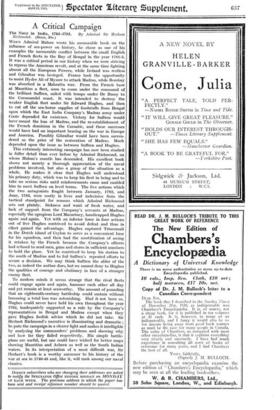A Critical Campaign
The Navy in India, 1763-1783. By Admiral Sir Herbert Richmond. (Bean, 30s.)
WHEN Admiral Mahan wrote his memorable book on the influence of sea-power on history, he chose as one of his examples the memorable conflict between the small English and French fleets in the Bay of Bengal in the year 1781-3. It was a critical period in our history when we were striving to repress the American revolt, and at the same time fighting almost all the European Powers, while Ireland was restless and Gibraltar was besieged. France took the opportunity to assist Hyder Ali of Mysore to attack Madras, while Bombay was absorbed in a Mahratta war. From the French base at Mauritius a fleet, soon to come under the command of the brilliant Suffren, sailed with troops under De Bussy to the Coromandel coast. It was intended to destroy the weaker English fleet under Sir Edward Hughes, and then to cut off the sea-borne supplies of foodstuffs from Bengal upon which the East India Company's Madras army under Coote depended for existence. Victory for Suffren would have meant the loss of Madras, and the re-establishment of the French dominion in the Carnatic, and these successes would have had an important bearing on the war in Europe and America. Possibly Gibraltar would have been surren- dered as the price of the restoration of Madras. Much depended upon the issue as between Suffren and Hughes.
This extremely interesting campaign has now been studied in fuller detail than ever before by Admiral Richmond, on whom Mahan's mantle has descended. His excellent book shows not merely a thorough appreciation of the naval problems involved, but also a grasp of the situation as a whole. He makes it clear that Hughes well understood his primary duty, which was to keep his fleet in being and to take no serious risks until reinforcements came and enabled him to meet Suffren on level terms. The five actions which the two antagonists fought between January, 1782, and June, 1783, were costly in lives and indecisive from the tactical standpoint for reasons which Admiral Richmond sets out plainly. Sickness and want of fresh water, and lack of support from the Company's servants at Madras, especially the egregious Lord Macartney, handicapped Hughes again and again. Yet with an inferior force in four actions out of five Hughes contrived to avoid defeat and thus in effect gained the advantage. Hughes captured Trincomali in the Dutch island of Ceylon to serve as a convenient base for his squadron, and then had the mortification of seeing it retaken by the French because the Company's officers had refused to send men, guns and stores in sufficient numbers to hold the place. Yet he contrived to keep his station to the south of Madras and to foil Suffren's repeated efforts to secure a decision. We may think Suffren the abler of the two, as indeed the author does, but we cannot deny to Hughes the qualities of courage and obstinacy in face of a stronger enemy fleet.
To modern minds it seems strange that the rival fleets could engage again and again, hammer each other all day and yet remain at least seaworthy. The amount of pounding that an eighteenth-century battleship could sustain without becoming a total loss was astonishing. Had it not been so, Hughes could never have held his own throughout the year 1782, inadequately supported as a rule by the Company's representatives in Bengal and Madras except when they gave Hughes foolish advice which he did not take. Sir Herbert Richmond's narrative is illuminating and dramatic ; he puts the campaign in a clearer light and makes it intelligible by analysing the commanders' problems and showing why and how far they failed respectively. His simple battle- plans are useful, but one could have wished for better maps showing Mauritius and Acheen as well as the South Indian waters. In its interpretation of a most difficult war, Sir Herbert's- book is a worthy successor to his history of the war at sea in 1740-48 and, like it, will rank among our naval classics.














































 Previous page
Previous page